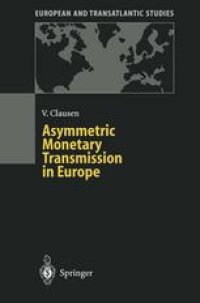
Ebook: Asymmetric Monetary Transmission in Europe
Author: Volker Clausen (auth.)
- Tags: Macroeconomics/Monetary Economics
- Series: European and Transatlantic Studies
- Year: 2001
- Publisher: Springer-Verlag Berlin Heidelberg
- Edition: 1
- Language: English
- pdf
The euro and the ESCB have started in January 1999 and there is naturally a wide-ranging interest in academia and among policymakers in OECD coun tries, how successful European Monetary Union will and can be. EMU has started with 11 countries and experienced a rapid depreciation of the cur rency. With so many EU countries joining for a historical monetary union in a period of economic globalization, international financial market changes and ongoing EU enlargement the problem of monetary policy efficiency becomes crucial; especially as so many countries in the EU still have high unemploy ment rates and the euro has just started at the beginning of a cyclical upswing in the euro zone. Monetary policy is also quite crucial, because the Maastricht convergence criteria severely restrict the scope of national fiscal policy. With a very limited stock of valuable European monetary experience which could be usefully exploited by the ECB and the ESCB respectively, one naturally will appreciate advanced economic modeling of the main issues. This book takes an analytical look at the problem of asymmetric monetary transmission in Euroland. Facing the ECB's monetary policy, individual mem ber countries are likely to experience different policy effects. Countries differ in their financial structure -a well-known argument in the literature -but also in the characteristics of goods and labor markets. The latter fields have been somewhat neglected in the literature but receive broad analytical attention here.
This study investigates whether the common monetary policy by the European Central Bank leads to asymmetric macroeconomic developments in the EU member countries. Several theoretical models of monetary unions are developed to assess how differences in particular channels of transmission translate into differences in the overall strength of monetary transmission within the EMU. As an extension to other studies in this field, we investigate not only the macroeconomic relevance of asymmetries in financial structure, but also the implications of asymmetries in goods and labor markets. In the empirical part, this study critically evaluates previous empirical evidence and presents new econometric results on asymmetric monetary transmission in Europe. The final part describes the structural changes after the establishment of EMU and evaluates their implications for asymmetric monetary transmission in Europe.